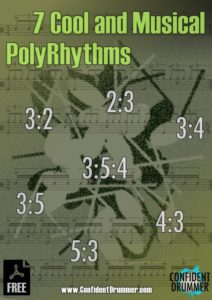Polyrhythms are one of the most interesting tools available to any musician. They can be used to unleash our creativity on many levels.
I think polyrhythms are fascinating to play, to hear, and first of all to understand.
They make things more interesting by adding variety to our phrasing, by giving us new ideas and also by increasing our technique, as they typically are pretty challenging to master.
In this study we practice 7 of the most interesting polyrhythms. From the classic examples to a couple of really advanced ones, which use quintuplets. And even a three layer polyrhythm! We can use these pages to understand how this system works and start to become acquainted with some musical implementation.
Here is a Pdf version of this lesson, with all transcriptions, for you to save and print:
As usual you can click on each of the exercises to go to its specific time in the YouTube video where I play them.
Put simply, we have a polyrhythm anytime two or more rhythms happen simultaneously, and therefore overlap.
This means we need to have a common pulse, a beginning point where the rhythms converge and then start again their own cadence.
The different patterns start together, then they separate, and eventually they join again in a given point, after a specific time. Then a new cycle can start.
Without these elements it’s not a polyrhythm, we just have two or more disconnected beats, even if they are played at the same time.
Even though a polyrhythm can involve multiple patterns, we usually only have two layers, and so we are going to focus mainly on this case.
Polyrhythms are written like a mathematical division: the numbers involved show how many notes are included in each rhythm.
The first number, the dividend, constitutes the size of the main cell/unit of notes. The second number, the divisor, points to the kind of grid over which the main cell is going to be displaced.
The rhythms involved merge and start a new cycle after a number of notes equivalent to the least common multiple between those two values.
For instance, if we play an accent every 3 notes (the cell) over eighth notes (the grid) we have a ‘3 against 2’ polyrhythm (which is written 3:2), and the common pulse happens when the two overlap every 3 quarter notes.
This is because the least common multiple between 3 and 2 is 6, and in 3/4 we have 6 eighth notes.
In the same way, if we play eighth note triplets with an accent every 4 notes, we are going to have a ‘4 against 3’ (4:3) polyrhythm.
In this case the overlap is going to be every 4 quarter notes, since the smallest common multiple between 3 and 4 is 12, and in 4/4 we have 12 eighth note triplets.
The length of the cycle, and the point where the overlap occurs, are determined by the least common multiple between all the rhythms involved even when we have more than two of them.
In fact, as we are going to see in the last example, which is a ‘3 and 5 against 4’, the starting spot in such case is every 60 notes.
In my opinion, even though it’s important to understand the theory behind them, these ideas are a lot easier to learn by actually playing them than by hearing the explanation.
I’ve put together a few of the most common ones, with a couple of examples for each case. ‘3 against 2’, ‘2 against 3’, ‘3 against 4’, ‘4 against 3’, ‘5 against 3’, ‘3 against 5’, and also ‘3 and 5 against 4’. ‘Against 5’ means we are playing quintuplet notes!
For each polyrhythms we are going to see three applications. First we are going to play it just on the Snare. Then we play it as a groove, displacing the polyrhythm between the Bass Drum and the Snare Drum.
Lastly we play the polyrhythmic cadence on the Hi-Hat, while Bass Drum and the Snare Drum execute a basic beat.
The final example, as mentioned before, is a 3 layer polyrhythm, where we have a 3 and 5 against 4, simultaneously. The least common multiple between 3, 4 and 5 is 60, and so each cycle lasts for 60 notes.
Therefore, as we can see in the transcription, which is in 5/4, each cycle includes 3 bars of 16th notes (three times 20 sixteenths).
I decided to play the 3 part on the Hi-Hat, and the 5 part with a Cross Stick pattern, while the Bass Drum plays constant 8th notes (the 4 part is the 16th notes grid).
By practicing these 7 examples we can understand how this system works and start to become acquainted with some musical implementation.
As soon as we feel comfortable with these, we can move on and start having fun with our own ideas, creating new variations and even using them in music that we are playing.
Polyrhythms allow us to achieve what is called ‘Implied Metric Modulation’. Metric Modulation is a technique that allows us to change the duration of the pulse rate.
With polyrhythms we don’t actually have a modulation, since the meter doesn’t change and the bpm at which we are playing stays the same the whole time.
The result that we obtain is exactly the same, but it’s important to note this distinction: with polyrhythms we are playing a rhythmic illusion, because the pulse doesn’t actually change.
In metric modulation, instead, we literally change the quarter note value. Therefore what we ear is not a rhythmic illusion, because even though the meters are related (as a result of the modulation), they are in fact different.
If you need more clarity about the theory and concepts of drumming, I recommend you spend a minute checking this in-depth method:
‘Theory & Concepts’ – Altitude Drumming – Volume 1



















